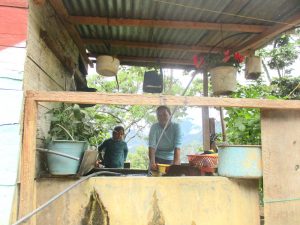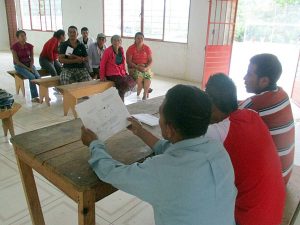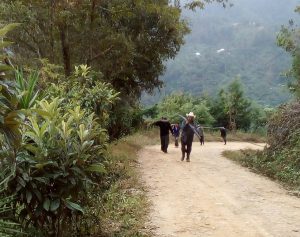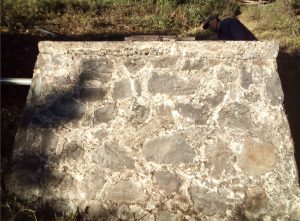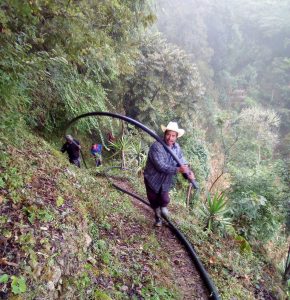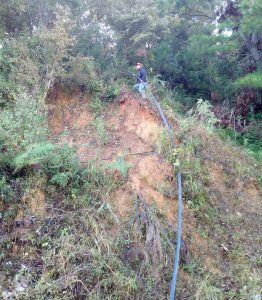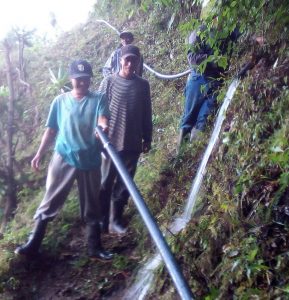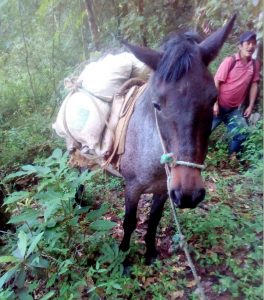This project is made possible through the partnership of WATER CHARITY and the NATIONAL PEACE CORPS ASSOCIATION.![]()
This project has been completed. To read about the conclusion, CLICK HERE.
Location
Loma Linda, Chiapas, Mexico
Community Description
Deep in the Sierra Madre Mountains in Chiapas, Mexico there is no television in the homes. In Loma Linda, there is no Internet either, and cell phones only have the reception at 6 a.m. for a little while. So, children enjoy a childhood freed from technologies that would otherwise make them sit still and opt for passive entertainment. Instead, they run and play all day in the rainforest and coffee groves. Teenagers spend afternoons shooting hoops at the school. It looks like what childhood used to be.
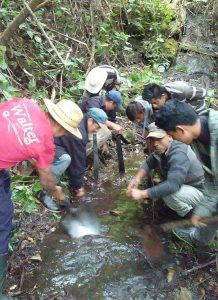 Loma Linda is home to 280 residents. All households depend on growing coffee for a living which affords people the most meager of incomes in good years. Recently, however, the rust plague, which is widely believed to be the result of the warming climate, has dramatically reduced yields. While a few families have small stores fronts in their homes, everyone grows their own corn and beans to keep their families fed. They raise a few chickens for the eggs and for meat a couple of times a year on special occasions.
Loma Linda is home to 280 residents. All households depend on growing coffee for a living which affords people the most meager of incomes in good years. Recently, however, the rust plague, which is widely believed to be the result of the warming climate, has dramatically reduced yields. While a few families have small stores fronts in their homes, everyone grows their own corn and beans to keep their families fed. They raise a few chickens for the eggs and for meat a couple of times a year on special occasions.
Problem Addressed
Loma Linda is another of the many villages in this impoverished mountainous region that suffered the destruction of essential infrastructure when Hurricane Stan did its damaged in 2005. The water system that they had relied on for many years was damaged beyond repair. Families have had to get water as best they can from tiny springs and creeks that inevitably dry up in the spring.
They have tried unsuccessfully to get help from the municipality of Siltepec on many occasions. Every time there is an election, the candidates have made promises to fix this situation. No one has followed through with their promises in eleven years.
Beyond the extreme inconvenience of raising a family without water, the lack of access to water has had a specific impact on household economies in the village. When the coffee is harvested it must be thoroughly washed on the same day to remove the fruit from the bean. Unfortunately for Loma Linda coffee farmers, right about the time the coffee beans have been painstakingly picked from trees on steep mountainsides, the local springs dry up. This means that farmers cannot properly wash the coffee. Instead, the sticky fruit pulp ferments on the beans and pretty much destroys their hopes of being able to obtain a good price for what would otherwise be considered exceptionally attractive coffee sought after by specialty buyers abroad.
Project Description
This project is to build a water system for Loma Linda.
T he community has identified two perennial creeks that are near each other. The system will draw water from each creek and bring it in one hose to a tank from which it will be distributed to all homes. The population has grown in the past decade since the natural disaster so this new system has been designed to provide water to new homes higher up the mountainside.
he community has identified two perennial creeks that are near each other. The system will draw water from each creek and bring it in one hose to a tank from which it will be distributed to all homes. The population has grown in the past decade since the natural disaster so this new system has been designed to provide water to new homes higher up the mountainside.
The plan is to build a dam at the highest end of each creek using what is called “piedra ahogada” construction whereby the masons use rock from the site that is encased in concrete reinforced with rebar. This is the strongest construction possible and is cost-effective since rock from the area will be used.
The distribution tank will also be built with rock and will be reinforced with “armex” in the traditional way to insure that it can withstand the pressure of the water when full. Armex is a rectangular structure made of rebar that is used to reinforce concrete columns. The water will come from the creeks in a 2″ hose for over a little more than 2 kilometers. The entire system will rely on gravity to bring the water to homes.
Loma Linda residents have formed a new water committee to oversee the work needed to build the new water system and to organize the work required to maintain the system once completed. They will insure that all residents properly conserve the water. Community members have agreed to work together to complete all work required to create a system that will last many decades. They are committed to making sure that all people living in the community benefit from the project with no household being left out due to topography.
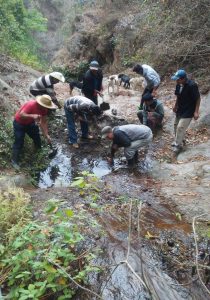 This village is located in the same valley where Sexto Sol and Water Charity have already successfully completed three water projects: Santa Domingo La Cascada, Cipresal La Cascada, and Hermosillo. The 9-kilometer road from the highway to the area is paved most of the way. Local providers sell cement and other building materials in La Cascada eliminating the need to transport materials from Motozintla, the city 3 hours away.
This village is located in the same valley where Sexto Sol and Water Charity have already successfully completed three water projects: Santa Domingo La Cascada, Cipresal La Cascada, and Hermosillo. The 9-kilometer road from the highway to the area is paved most of the way. Local providers sell cement and other building materials in La Cascada eliminating the need to transport materials from Motozintla, the city 3 hours away.
Project Impact
280 people will benefit from the project.
Project Manager
The project will be administered by Tamara Brennan, Ph.D. of The Sexto Sol Center for Community Action, an award-winning non-profit that has had a permanent presence in the region since 1997.
This project is the 12th water system project in the ongoing Sierra Madre Water Program, a comprehensive effort to improve water access in the underserved and impoverished Sierra Madre de Chiapas region of Mexico, spanning the border with Guatemala.
Monitoring and Maintenance
The water committee will monitor the functioning of the system, and perform maintenance and repairs. Sexto Sol will periodically check to ascertain that the system is working properly.
Comments
This project is the 11th water system project in the ongoing Sierra Madre Water Program, a comprehensive effort to improve water access in the underserved and impoverished Sierra Madre de Chiapas region of Mexico, spanning the border with Guatemala.
Fundraising Target
$6,500
Funds raised in excess of the project amount will be allocated to other projects in the country.
Donations Collected to Date
$6,500
Dollar Amount Needed
$0 – This project has been funded through the generosity of Michael and Carla Boyle, of Nelsonville, Ohio.
If you wish to donate for our next project in Mexico, please use the Donate button below.
Conclusion of Loma Linda Water Project – Mexico
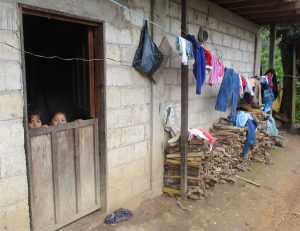
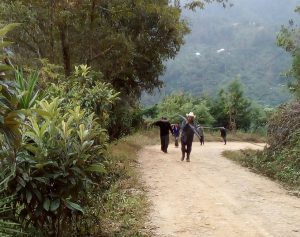
This project has been completed under the direction of Tamara Brennan, Ph.D. of The Sexto Sol Center for Community Action. To read about the start of the project, CLICK HERE.
The project was designed to build a water system for Loma Linda.
Tamara reports:
When the elected representative of Loma Linda community first came to ask for help, he cited the lack of water as a major impediment to farmers being able to sell their coffee for a good price. For this reason, this project began with a challenge to get the water flowing in time for the 2018 coffee harvest.
Despite a major delay when a large landslide cut off the road during the rainy season, we did it! By mid-January the farmers began picking their coffee while having the confidence that they could finally properly prepare it for sale. This will help them in the future to be able to join collectives that seek to directly export their exceptional coffee for a better price.
It took a lot of intense effort build the water system given how the three structures that were built required hauling heavy stone and sand up steep cliffs from creek beds below. Horses were used to move the heavy material.
Two dams were built, one at the head of each creek. One of these required the men to manage passing the rock up a small cliff at the base of the dam. They are pleased with the way the stone holding tank turned out since the goal was to build a solid structure that would last for decades. A metal lid was installed that is locked to prevent vandalism.
The people in Loma Linda village extend their most sincere thanks to Michael and Carla Boyle, sponsors of this project, for kindly giving them the opportunity to make this significant improvement to their quality of life. Please note that the population in the village will increase by 1 this March, a week before the planned inauguration celebration is to take place.
We extend our thanks to Tamara for completing this important project and again thank the Boyles for providing the funding.
